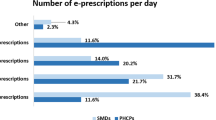Abstract
To review current practices regarding prescribing controlled substances at an academic medical center and describe possible advantages of electronic prescribing of controlled substances (EPCS). A 10-question multiple choice survey was sent electronically to all house staff at an academic medical center. Aggregated data was analyzed for trends. 193 surveys (18.8 %) were completed. Of all respondents, 46.6 % were not able to write their own prescriptions. 70.0 % have used another provider’s prescription pad to write prescriptions. 53.4 % have had prescriptions rejected or not filled by a pharmacy for being written incorrectly. 59.6 % kept a patient as an inpatient for a longer period of time due to the inability to obtain a prescription, costing an estimated $3.28 million per year. 58.0 % needed to have a patient return to the hospital to pick up prescriptions for an estimated 1583 return trips to the hospital yearly. 35.1 % had a patient return to the emergency department due to uncontrolled pain, estimated at $139,000 in yearly emergency department patient charges. The authors’ survey highlights some of the financial, legal, efficiency, and satisfaction disadvantages due to the inability to use EPCS. Implementing EPCS and making it ubiquitous may limit some inefficiencies in academic hospital systems.

Similar content being viewed by others
References
Lapane, K.L., Rosen, R.K., and Dubé, C., Perceptions of e-prescribing efficiencies and inefficiencies in ambulatory care. International Journal of Medical Informatics. 80(1):39–46, January 2011.
Kaushal, R., Kern, L.M., Barron, Y., Quaresimo, J., and Abramson, E., Electronic prescribes improves medication safety in community-based office practices. Journal of General Internal Medicine. 25(6):530–536, June 2010.
https://www.health.ny.gov/professionals/narcotic/electronic_prescribing/. Website of New York State Department of Health. 1 May 2015.
https://www.federalregister.gov/articles/2010/03/31/2010-6687/electronic-prescriptions-for-controlled-substances. Daily Journal of the United States Federal Government. 1 May 2015.
Thomas, C.P., Kim, M., McDonald, A., Kreiner, P., Kelleher, S.J., Blackman, M.B., Kaufman, P.N., and Carrow, G.M., Prescribers' expectations and barriers to electronic prescribing of controlled substances. Journal of the American Medical Informatics Association May. 19(3):375–381, 2012.
http://www.cms.gov/Regulations-and-Guidance/Legislation/EHRIncentivePrograms/downloads/Stage2_EPCore_2_ePrescribing.pdf. Pamphlet released by the Centers for Medicare and Medicaid Services. 1 May 2015.
Ingrim NB, Hokanson JA, Guernsey BG, Doutré WH, Blair CW Jr, Verrett TJ. Physician Noncompliance with Prescription-Writing Requirements. Am J Hosp Pharm. March 1983; 40(3):414–417
Author information
Authors and Affiliations
Corresponding author
Ethics declarations
All of the authors believe this manuscript to be ethical and they stand by the work in this manuscript. In addition, there were no human or animal subjects used in this research.
Conflict of Interest
None of the authors listed above have any actual or potential conflict of interest including any financial, personal or other relationships with other people or organizations within three years of beginning the submitted work that could inappropriately influence, or be perceived to influence, their work.
Prior Publication Statement
This work has not been published anywhere prior to the attempted publication at the Journal of Medical Systems. It was, however, presented in raw form at a symposium for resident health informaticists at UCLA where it received commendation for its potential effects on the University of California health care system.
Additional information
This article is part of the Topical Collection on Systems-Level Quality Improvement
Appendix 1
Appendix 1
-
1)
What is your specialty?
A: drop-down menu
-
2)
Are you able to write your own prescription medications under your own DEA number?
A: Yes or No
-
3)
In the past 12 months, have you ever needed to use another’s prescription pad to write prescriptions for a patient under your care?
A: Yes or No
-
4)
In the past 12 months, have you ever had to give out your own prescriptions to other residents so they could write prescriptions for a patient under their care?
A: Yes or No
-
5)
In the past 12 months, have you ever had difficulty obtaining prescription pads for a patient under your care?
A: Yes or No
-
6)
In the past 12 months, have you ever had a prescription you wrote rejected or not filled by a pharmacy because it was written incorrectly? If yes, how many times?
A: No or Once or Twice or Three times or Four times or At least five times
-
7)
In the past 12 months, have you ever had to keep a patient in house for a longer period of time in order to get them the prescriptions they needed for discharge? If yes, how many times?
A: No or Once or Twice or Three times or Four times or At least five times
-
8)
In the past 12 months, have you ever had to have a patient return to the hospital to pick up prescriptions that you could not send directly to their pharmacy? If yes, how many times?
A: No or Once or Twice or Three times or Four times or At least five times
-
9)
In the past 12 months, have you ever had a patient go to the emergency room because you could not adequately control their pain and could not get them the prescriptions they needed? If yes, how many times?
A: No or Once or Twice or Three times or Four times or At least five times
-
10)
On a scale of 1–10, how helpful would it be to have the ability to E-prescribe controlled substances?
A: List from 1 to 10.
Rights and permissions
About this article
Cite this article
Kupperman, E., Vigil, D., Yazdani, A. et al. Model of Current Practice Regarding Prescriptions of Controlled Substances and the Perceived Benefits of E-Prescribing in an Academic Medical Center. J Med Syst 40, 278 (2016). https://doi.org/10.1007/s10916-016-0646-7
Received:
Accepted:
Published:
DOI: https://doi.org/10.1007/s10916-016-0646-7




